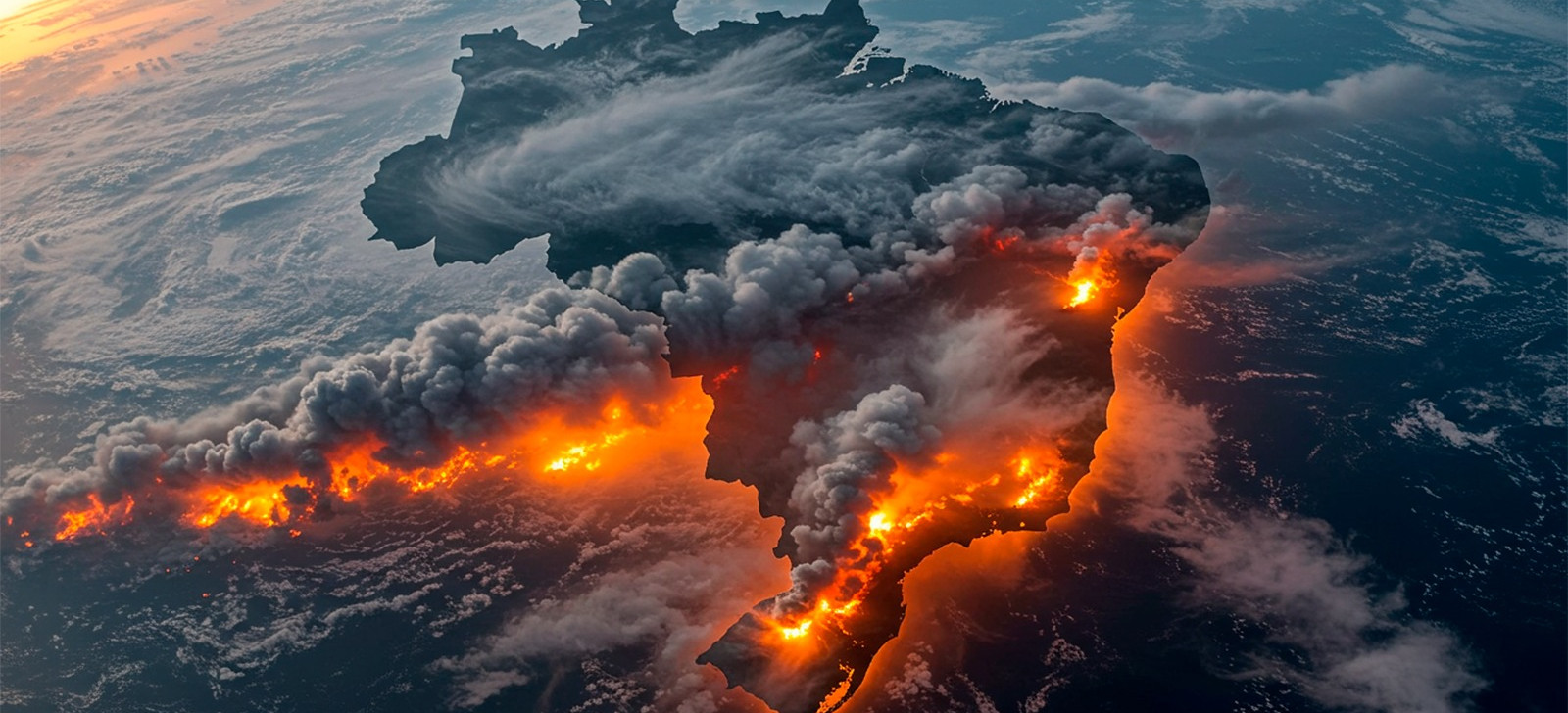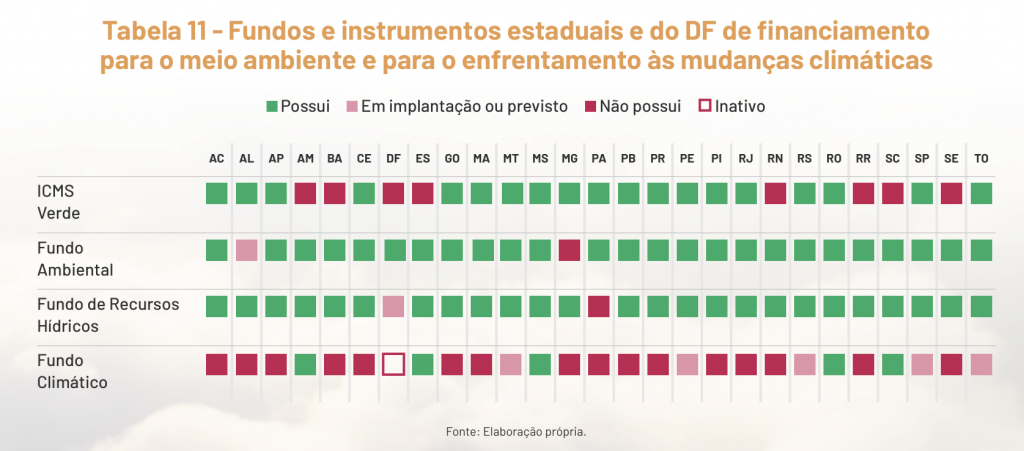Only three Brazilian states have climate change plans
01 de February de 2025

By Ana Cláudia Leocádio – From Cenarium
BRASÍLIA (DF) – Only three states have policies and plans for climate change, according to the “State Climate Change Yearbook”, released on Thursday afternoon, the 30th, in Brasília. In total, six types of formal instruments were evaluated to meet the needs of a solid policy in the area. Only Espírito Santo, Paraná, and the Federal District have successfully approved them within their administrative structures.
Prepared for over a year, the Yearbook is a project of the Brazil Climate Center (CBC) and the Climate and Society Institute (ICS), supported by Itaúsa. It consists of 284 pages with detailed information about each federation unit and how the states are addressing climate change.
Regarding the existence of climate change plans and policies, researchers highlighted the need for six documents: State Climate Change Policy; State Climate Change Plan or Strategy; Civil Defense Contingency Plan; State Greenhouse Gas (GHG) Emissions Inventory; Emission Mitigation Plan; and Climate Change Adaptation Plan.

The worst situation is in the state of Rio Grande do Norte, which is still in the process of developing its State Climate Change Plan and lacks any of the other instruments.
Among the nine states of the Legal Amazon, Maranhão, Amapá, and Roraima also present a concerning scenario. The Maranhão and Roraima governments reported having only the State Climate Change Policy, while the Amapá government stated it only has the Civil Defense Contingency Plan. Rondônia has both the Climate Change Policy and the Civil Defense Plan.
The best-performing state is Acre, which possesses five instruments and is in the process of developing or reviewing its State Climate Change Plan and/or Strategy. Amazonas has met four of the requirements, lacking its State Greenhouse Gas (GHG) Emissions Inventory and Climate Change Adaptation Plan.
The study provides an updated overview of each state and presents a series of programs through which they can be integrated into climate change mitigation efforts and advance their policies.
According to the document, only the states of Maranhão, Mato Grosso, and Mato Grosso do Sul receive federal government support for four types of listed programs, for example.
The survey also investigated the status of the federation units regarding environmental, climate, and water resource funds, as well as the Green ICMS (Tax on Circulation of Goods and Services). Only Mato Grosso do Sul and Rondônia have all four funds presented.
“States are advancing in creating specific climate change funds, unlinking them from state environmental funds. Some climate change funds promote an innovative approach, such as Espírito Santo’s City Fund, aimed at local adaptation projects, and FINACLIMA (SP), for private sector projects,” the Yearbook reports.

Nine states are eligible for the policy of Reducing Emissions from Deforestation and Forest Degradation (REDD+), which includes implementing conservation policies and demonstrating measurable reductions in deforestation and forest degradation. Of the eligible states, seven belong to the Legal Amazon.
The Yearbook also identifies Mato Grosso and Pará as the largest carbon dioxide (CO₂) emitters in the atmosphere, linked to emissions from land-use changes. São Paulo and Rio de Janeiro, for example, have high emissions related to energy sources, while Minas Gerais and Mato Grosso do Sul’s emissions are primarily from agriculture.
One striking finding is that Acre, despite lower emission rates compared to 19 states, showed a high carbon intensity due to deforestation, which has not generated wealth and contributes to the state’s low Gross Domestic Product (GDP). “Roraima’s carbon intensity became negative in 2022, influenced by reduced deforestation in the state,” the study explains.
In addition to presenting the information contained in the document, panels were held with representatives from federal and state governments, audit courts, and civil society organizations. Speakers emphasized the importance of the high-quality information provided by the Yearbook, which will better guide state managers in addressing the urgency of climate change mitigation, currently causing significant global issues.
Júlio Pinheiro, a counselor at the Amazonas State Court of Accounts (TCE-AM), representing the Amazonas government at the event, is part of the Technical Committee on Environment and Sustainability of the Rui Barbosa Institute. According to Pinheiro, the institute is a pioneer in projects in this field and frequently conducts audits in specific state sectors.
Challenges in Securing Funding
One of the key contributors to the 284-page Yearbook, Fernanda Fortes Westin, explained that the research demonstrated that all 26 states and the Federal District are beginning to focus on climate change, as many are resuming the legal framework necessary to support project implementation, particularly adaptation initiatives.
“We see that, despite being recent, many are integrating into global initiatives like ‘Race to Zero,’ which aims to reach zero emissions by 2030 or 2050”, emphasized Westin, who holds a PhD in Energy and Environmental Planning (COPPE/UFRJ) and is a senior consultant at the Brazil Climate Center (CBC).
The biggest challenge, according to Westin, is securing funding for projects since Brazil is highly dependent on international financial resources. “We need to make progress, especially regarding state adaptation plans, as only a few have them, and those that do lack resources for implementation. This is another concern highlighted in the Yearbook—the necessity of securing resources,” the researcher pointed out.
Westin noted that several funds finance climate projects, and there are promising experiences in creating state climate change funds that could help achieve the objectives.
One concern is wildfires, which hit record levels in Brazil in 2024, especially in the Pantanal and Amazon, and must not continue to escalate.
Regarding the Amazon, the Yearbook raised concerns about the new Forest Code allowing states with ecological and economic zoning to reduce the legal permanent preservation reserve from 80% to 50%. “We worry about how this could increase deforestation in these Amazonian areas, which have many legal reserves. How these policies may influence states to preserve these forests and decarbonize is a critical concern,” the study evaluated.
According to the researcher, following this initial diagnosis presented in the Yearbook, the plan is to track progress to determine whether states have advanced or regressed in their policies and plans. States can also contact the institutions to update their information.
Importance of State Support
The Minister of Environment and Climate Change, Marina Silva, emphasized the importance of state participation in efforts to mitigate climate change effects and hopes for more than just command-and-control actions but also increased sustainable development initiatives and policy funding.
Marina recalled the challenges faced since taking office, starting with budget constraints and staff shortages. “When I left 16 years ago, I had 1,700 inspectors; when I returned, there were only 700,” she stated.
Nevertheless, the minister said her ministry’s actions have reduced deforestation by 45% in the Amazon, 27% in the Atlantic Forest, 77% in the Pantanal, and 48% in the Cerrado.
“This effort must always be a joint one with the states, within their competencies. We are also strengthening the agenda to combat wildfires, as they are a key driver of forest degradation,” she declared.
According to Marina, regarding the Amazon, there is a partnership using resources from the Amazon Fund, in which municipalities with the highest deforestation rates participate in a cooperation agreement that includes sustainable development plans and land regularization processes.
Methodology
Analysis categories for states in the Yearbook:
- Governance and Financing (State Plans, ABC+*)
- Agriculture (ABC and ABC+ Plans, Pastures)
- Energy (Electricity matrix and production per state, local incentives for renewable energy)
- Land-Use Changes (Wildfire data, REDD, PES, reforestation)
- Industry (Decarbonization potential)
- Waste
- Adaptation – Vulnerability, risk management
*Low-Carbon Agriculture (ABC)
Source: State Climate Change Yearbook

